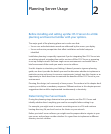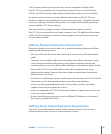
Understanding Backup and Restore Policies
There are many reasons to have a backup and restore policy. Your data is subject
to failure because of failed components, natural or manmade disasters, or data
corruption. Sometimes data loss is beyond your control to prevent, but with a backup
and restore plan, you can restore your data.
You need to customize backup and restore policies to take into account your situation,
what data needs to be saved, how often, and how much time and eort is used to
restore it. Your policy species the procedures and practices that fulll your restoration
needs.
Backups are an investment of time, money, and administration eort, and they can
aect performance. However, there is a clear return on investment in the form of data
integrity. You can avoid substantial nancial, legal, and organizational costs with a well-
planned, well-executed backup and restore policy.
There are essentially three kinds of restoration needs:
Restoring a deleted or corrupt le Â
Recovering from disk failure (or catastrophic le deletion) Â
Archiving data for an organization need (nancial, legal, or other need) Â
Each restoration need determines the type, frequency, and method you use to back up
your data.
You might want to keep daily backups of les. This allows for quick restoration of
overwritten or deleted les. In such a case you have le-level granularity every
day: any single le can be restored the following day.
There are other levels of granularity as well. For example, you might need to restore
a full day’s data. This is a daily snapshot-level granularity: you can restore your
organization’s data as it was on a given day.
These daily snapshots might not be practical to maintain every day, so you might
choose to keep a set of rolling snapshots that give you daily snapshot-level granularity
for only the preceding month.
Other levels of restoration you might want or need could be quarterly or semiannually.
You might also need archival storage, which is data stored only to be accessed in
uncommon circumstances. Archival storage can be permanent, meaning the data is
kept for the foreseeable future.
32 Chapter 2 Planning Server Usage


















